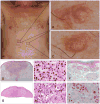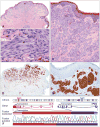Genomic aberrations in spitzoid melanocytic tumours and their implications for diagnosis, prognosis and therapy
- PMID: 27020384
- PMCID: PMC4817351
- DOI: 10.1016/j.pathol.2015.12.007
Genomic aberrations in spitzoid melanocytic tumours and their implications for diagnosis, prognosis and therapy
Abstract
Histopathological evaluation of melanocytic tumours usually allows reliable distinction of benign melanocytic naevi from melanoma. More difficult is the histopathological classification of Spitz tumours, a heterogeneous group of tumours composed of large epithelioid or spindle-shaped melanocytes. Spitz tumours are biologically distinct from conventional melanocytic naevi and melanoma, as exemplified by their distinct patterns of genetic aberrations. Whereas common acquired naevi and melanoma often harbour BRAF mutations, NRAS mutations, or inactivation of NF1, Spitz tumours show HRAS mutations, inactivation of BAP1 (often combined with BRAF mutations), or genomic rearrangements involving the kinases ALK, ROS1, NTRK1, BRAF, RET, and MET. In Spitz naevi, which lack significant histological atypia, all of these mitogenic driver aberrations trigger rapid cell proliferation, but after an initial growth phase, various tumour suppressive mechanisms stably block further growth. In some tumours, additional genomic aberrations may abrogate various tumour suppressive mechanisms, such as cell-cycle arrest, telomere shortening, or DNA damage response. The melanocytes then start to grow in a less organised fashion and may spread to regional lymph nodes, and are termed atypical Spitz tumours. Upon acquisition of even more aberrations, which often activate additional oncogenic pathways or alter cell differentiation, the neoplastic cells become entirely malignant and may colonise and take over distant organs (spitzoid melanoma). The sequential acquisition of genomic aberrations suggests that Spitz tumours represent a continuous biological spectrum, rather than a dichotomy of benign versus malignant, and that tumours with ambiguous histological features (atypical Spitz tumours) might be best classified as low-grade melanocytic tumours. The number of genetic aberrations usually correlates with the degree of histological atypia and explains why existing ancillary genetic techniques, such as array comparative genomic hybridisation (CGH) or fluorescence in situ hybridisation (FISH), are usually capable of accurately classifying histologically benign and malignant Spitz tumours, but are not very helpful in the diagnosis of ambiguous melanocytic lesions. Nevertheless, we expect that progress in our understanding of tumour progression will refine the classification of spitzoid melanocytic tumours in the near future. By integrating clinical, pathological, and genetic criteria, distinct tumour subsets will be defined within the heterogeneous group of Spitz tumours, which will eventually lead to improvements in diagnosis, prognosis and therapy.
Keywords: BAP1; BRAF; Biomarkers; RAS; Spitz tumours; classification; diagnosis; genetics; genomics; melanocytic tumours; melanoma; molecular biology; pathology; precision oncology; spitzoid neoplasms; targeted therapy.
Copyright © 2015 The Royal College of Pathologists of Australasia. All rights reserved.
Conflict of interest statement
The authors state that there are no conflicts of interest to disclose.
Figures












Comment in
-
Diagnostic problems in spitzoid neoplasms.Pathology. 2017 Apr;49(3):325-326. doi: 10.1016/j.pathol.2016.11.018. Epub 2017 Mar 6. Pathology. 2017. PMID: 28274668 No abstract available.
References
-
- Barnhill RL. The Spitzoid lesion: rethinking Spitz tumors, atypical variants, ‘Spitzoid melanoma’ and risk assessment. Mod Pathol. 2006;19(Suppl 2):S21–33. - PubMed
-
- Ludgate MW, Fullen DR, Lee J, et al. The atypical Spitz tumor of uncertain biologic potential: a series of 67 patients from a single institution. Cancer. 2009;115:631–41. - PubMed
-
- Murali R, Sharma RN, Thompson JF, et al. Sentinel lymph node biopsy in histologically ambiguous melanocytic tumors with spitzoid features (so-called atypical spitzoid tumors) Ann Surg Oncol. 2008;15:302–9. - PubMed
Publication types
MeSH terms
Substances
Grants and funding
LinkOut - more resources
Full Text Sources
Other Literature Sources
Medical
Research Materials
Miscellaneous

